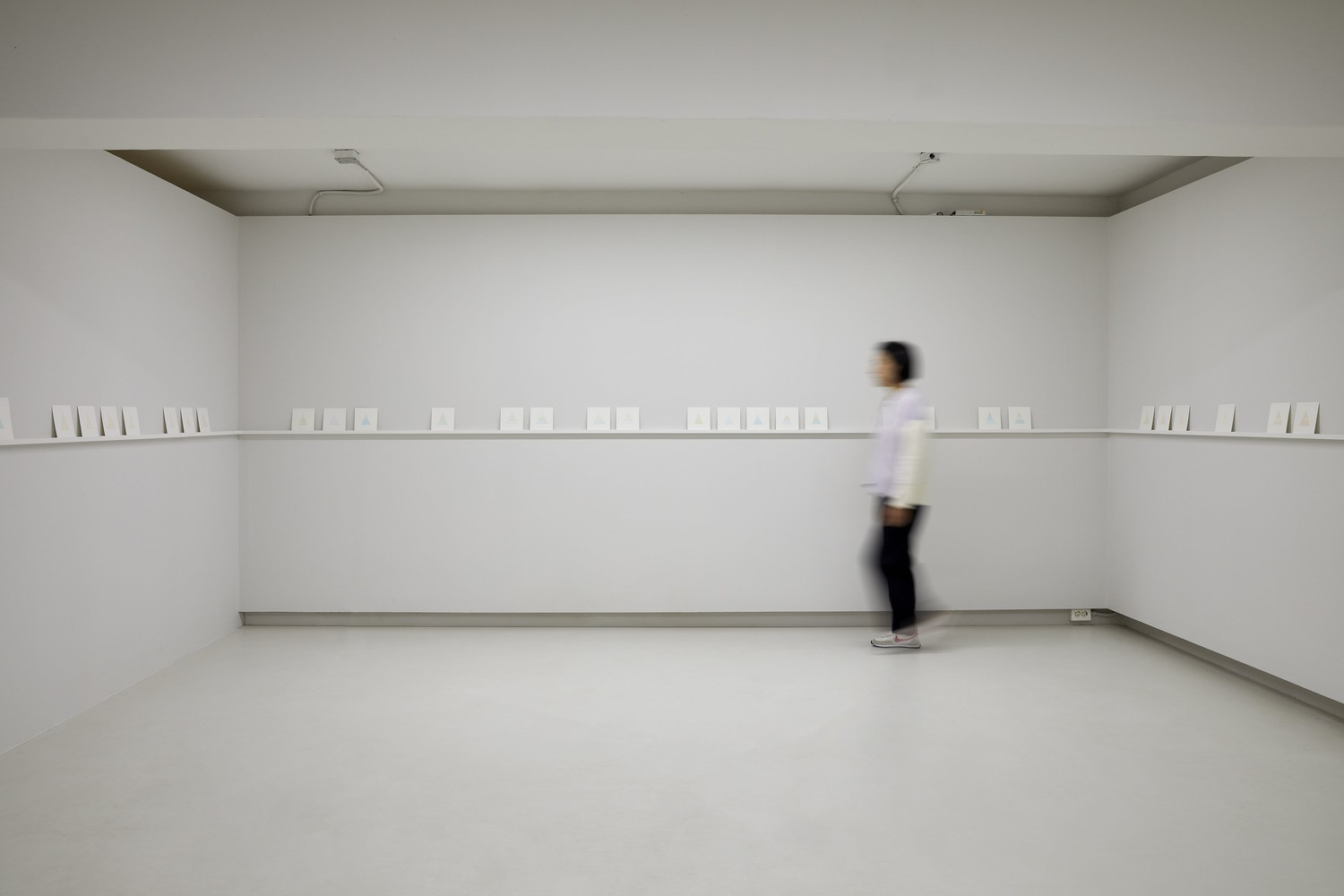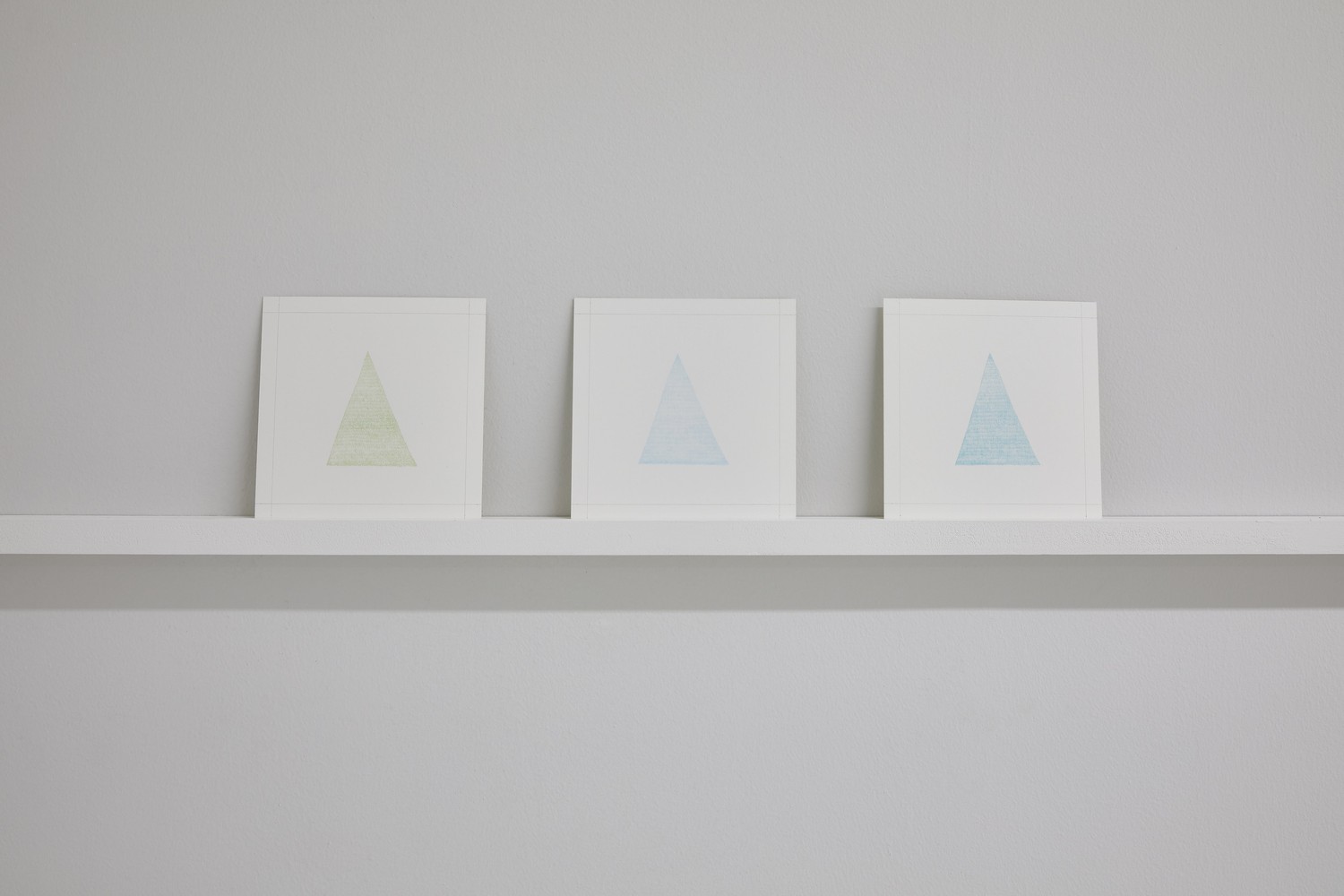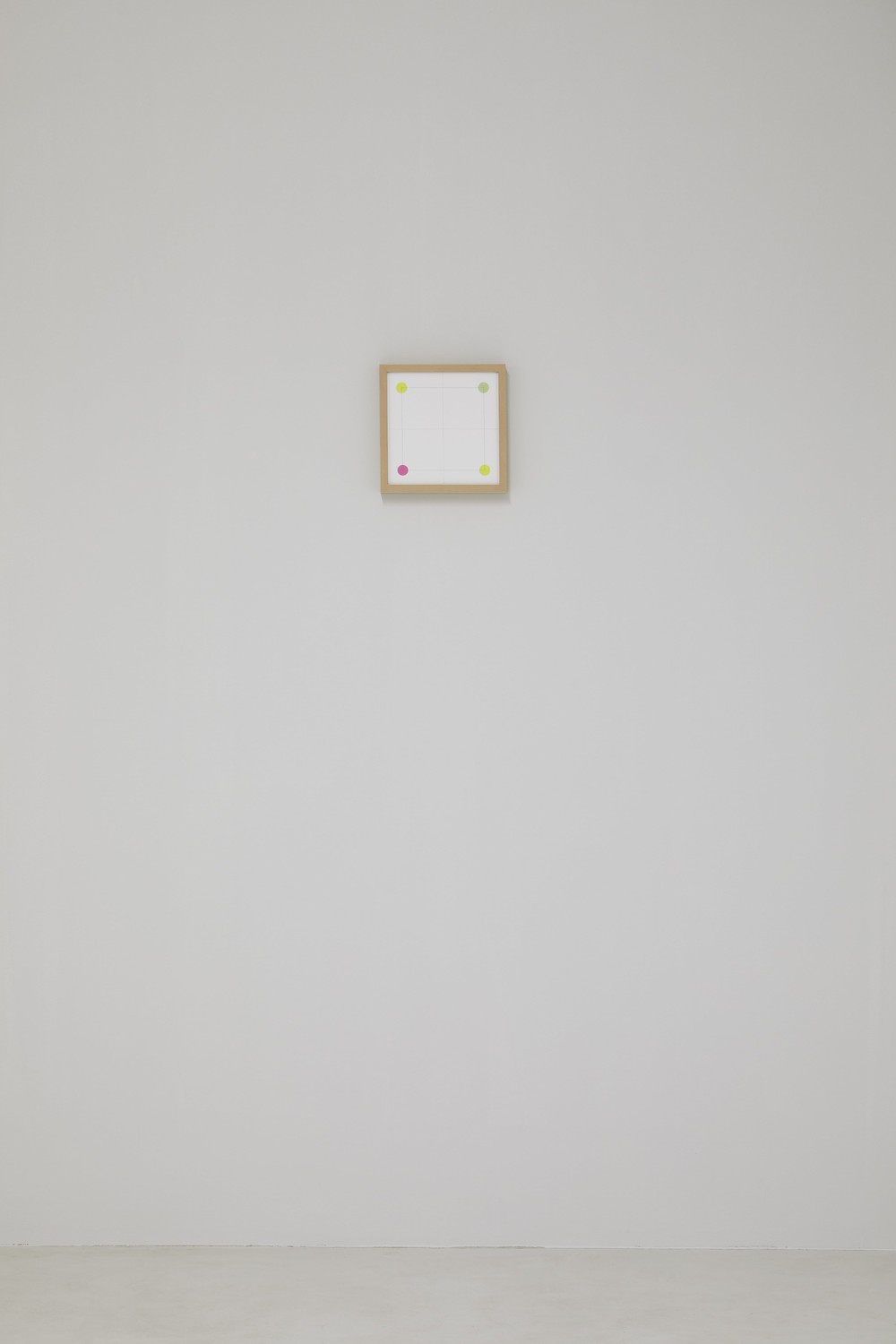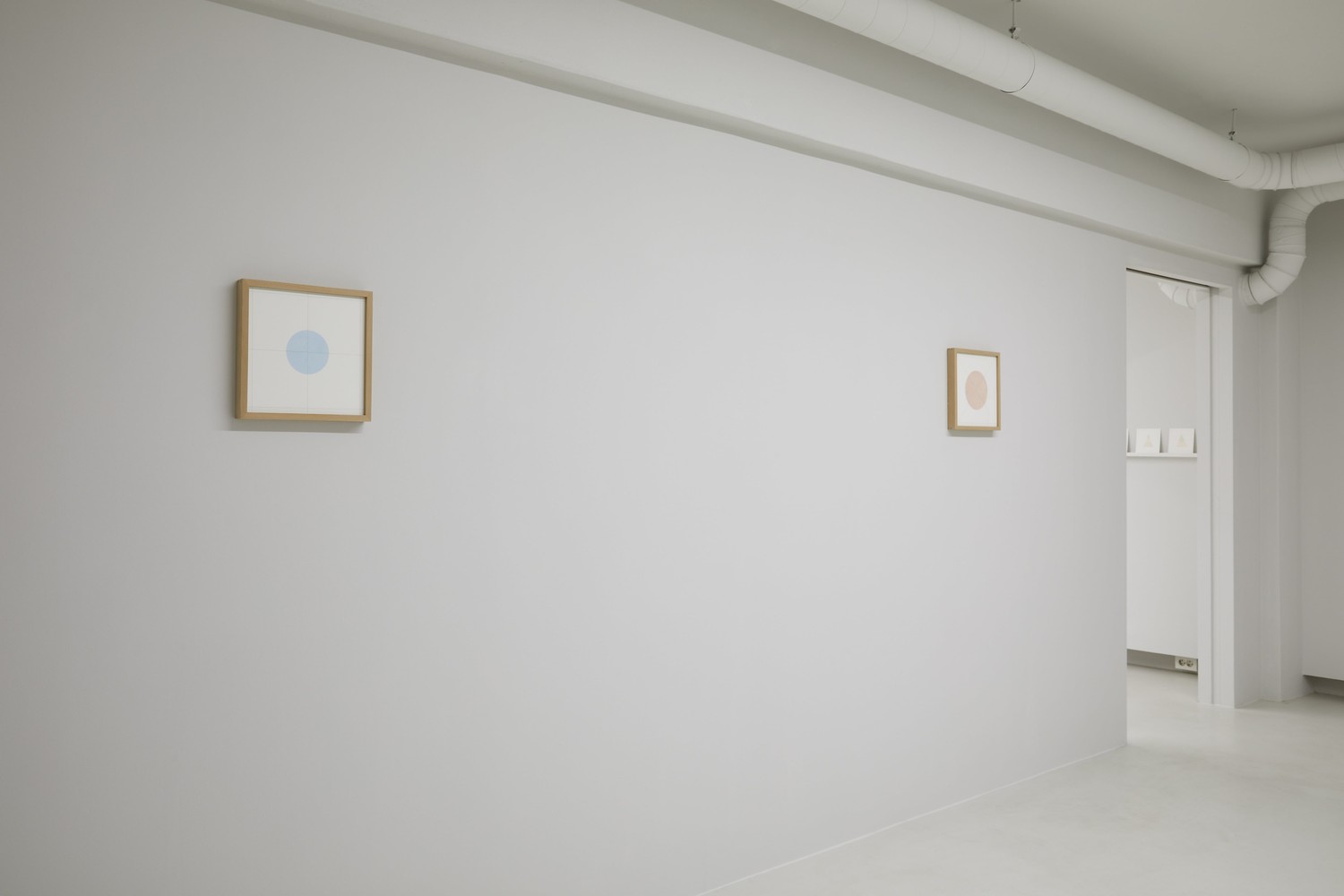
installation_view1

installation_view2

installation_view3

installation_view4

installation_view5
On Paper : the state of being
여기 정사각형의 새하얀 종이들이 있습니다. 거기엔 가느다란 연필 선으로 표시된 그리드가 있고, 그 안에는 정해진 위치에 그려진 삼각형이 있습니다. 각각의 삼각형은 색연필로 채색된, 서로 다른, 유일한 것입니다. 종이의 크기는 135 × 135mm, 160 × 160mm, 혹은 170 × 170mm 일수도 있지만 중요한 것은 아마도 그것이 정사각형이라는 점일 것입니다. 김지영 작가의 이전 전시를 보신 분은 이런 식으로 섬세하게 그려진 그의 사각형, 원, 교차하는 직선들과 색 점들을 기억하실 겁니다. 이번에 새롭게 선보이는 삼각형 시리즈 드로잉에서는 예전 작업에서 드러나는 특징적 요소들과 더불어 색다른 변화도 엿보입니다. 그것이 단지 표면적인 부분에서의 변화에 지나지 않는 것인지 어떤지는 아직 확신하기 어렵습니다. 일단 김지영 작가는 화면을 구성하는 모든 요소에 대해서 체계를 잡고 의미를 부여합니다. 그러므로 무언가 새로운 요소가 거기 존재한다면, 그것은 결코 우연이 아닐 것입니다. 그의 작품 속에서 선의 방향, 도형의 크기, 구획을 메운 색채, 선의 길이는 모두 섬세하게 조율된 의도적인 것들이기 때문입니다. 물론 작업이 정해진 방식을 따라 신중히 진행된다 해도, 단박에 그의 내면의 상태가 오롯이 한 장의 이미지로 완성되는 것은 아닙니다. 작가의 말에 의하면, 최종적인 드로잉에 도달하기 위해서는 ‘과정의 드로잉’이 필수적이라고 합니다. 그리고 이러한 과정 드로잉들은 작가의 생각의 흐름을 보여주는 단서가 되겠지요. 작가는 계속해서 변화하는 자기 존재의 상태를 차분히 들여다보고, 그것의 형태를 종이 위에 그려 나갑니다.
하얀 정사각의 틀, 연필로 그려진 가이드라인이 어떤 종류의 시공간을 은유한다면 색채는 작가의 정서적 상태를 표현합니다. 더 정확한 표현을 위해 그는 각각의 감정과 색채를 페어링하고 직접 만든 색에 색 이름을 붙이기도 하면서 자신만의 색채 팔렛트를 신중하게 구축합니다. 예컨대 ‘light-apricot’는 슬픔을, ‘deep-magenta’는 행복을, ‘sky-blue’는 근심 없음 ( light-heartedness )을 상징합니다. 틀림없이 작가 본인에게 있어서 이 드로잉들은 스스로를 관찰해서 얻은 특정 정보들과 서사성, 미적 요소들이 담겨있는 구체적인 ‘의미의 집합체’가 되는 듯합니다. 그러나 그의 작업이 작가 자신의 개인적 상태의 기록이라는 측면을 지닐지언정 어떠한 구체적 단서도 등장하지 않는 심플하고 기하학적인 형태를 가졌으므로, 관람객들에게는 당연히 모호하고 추상적입니다.
그럼에도 불구하고 우리는 그의 작품을 능동적으로 감상하면서 어떤 예술적 가치와 의미를 찾아낼 수 있을까요? 사각의 흰 종이를 다시 한 번 자세히 들여다봅니다. 서로 비슷비슷하게 보이는 그의 삼각형들은 마치 크리스마스 트리나 생태 피라미드처럼 보이기도 합니다. 정돈된 형태와 섬세한 색연필 스트로크는 그의 드로잉에 분명히 어떤 미감적 속성을 부여하고 있는 듯하지만, 그 아름다움이 작가의 의도에 분명하게 포함되는 것인지는 확신할 수 없습니다. 아마도 작가 개인에게 있어서 그의 작업은 내면의 균형을 지키고 삶에 안정감을 주는 반복적인 루틴으로서의 의미가 있으리라는 추측을 해봅니다.
우리는 무엇을 찾아야 할까요? 전시된 작품을 감상하면서 당신이 발견하는 어떠한 단서도 사소하지 않을 것입니다. 누군가는 왼쪽으로 살짝 치우친 듯 보이는 이등변 삼각형의 꼭지각 방향과 그 오른쪽 사선의 흔들리는 외곽선을 보고 작가가 오른손잡이일 것이라는 추측을 할 수도 있습니다. 그리고 색에 더 많은 관심을 기울이는 또 다른 감상자는 그의 감정-색채의 페어링에 관한 독특한 감상을 떠올릴 수도 있습니다. 기본적으로 그의 드로잉들은 일정한 규칙에 따르는 일률적인 형태가 반복, 변형되는 것이므로, 어떤 관객은 그 규칙이 대체 철학적, 예술적으로 어떤 의미를 가질 수 있는지 호기심을 가질 수도 있습니다. 그러나 많은 수의 관람객들이 가질 수 있는 가장 평범한 질문이라고 한다면, 그가 자신의 심리적 상태를 표현하기 위해 고정된 틀에서 숙고할 때, 덧없이 휘발하고 마는 성질의 미묘하지만 강력한 다른 수많은 감정들은 과연 어떻게 다룰 것이냐 하는 문제일 수도 있습니다. 더 나아가 ‘감정’이라는 것이 회상하고 반추하여 종이 위에서 도식적으로 이미지화 할 수 있는 단순한 것이라는 전제 자체를 인정할 수 없는 사람도 있을 것입니다.
다양한 질문과 단서들이 이곳 전시장을 채우고 있습니다. 김지영 작가에 대한 어떠한 개인적 정보나 친밀감 없이도 우리는 감정에 대한 그의 집요하고 끈질긴 탐구의 결과물을 감상할 수 있습니다. 여기서 어떤 의미를 찾아내는 것은 오롯이 당신에게 달려있습니다. 다만 작가의 감정에 대한 분석과 표현을 이해하기 위해서 우리는 완벽히 이성적인 방식으로 애를 써야만 할지도 모릅니다.
먹구름
(ENG)
On Paper : the state of being
Here is a white square paper. There's a grid drawn with a thin pencil line, and inside that grid, a triangle is drawn on a predetermined position. Each triangle is colored with a colored pencil, different each other, and the only one. The size of these papers could be 135×135 mm, 160×160 mm, or 170×170 mm, but maybe the important thing is that they all have a square form. If you've seen Kim Gi-young's previous exhibition, you'll remember her squares, circles, intersecting lines and color dots that are delicately drawn in this way. In this new series of triangle drawings, you can see some changes along with the characteristic elements that were revealed in the previous work. It's still hard to be sure whether it's nothing more than a superficial change. However, Kim Gi-young builds a system and gives meaning to all the elements that make up her paintings. So if something new is there, it's never going to be a coincidence. Because in her work, the direction of the lines, the size of the figures, the color that filled the shapes, the length of the lines are all intentional things that are finely tuned. Of course, even if the work is done carefully in a set way, her inner state does not complete itself with a single image in a single moment. According to the artist, 'process drawings' are essential to reach the final drawing. And these process drawings will be a clue about the flow of the artist's thought. The artist continues to observe changes in the state of her 'being' and draws its form on paper.
If the white square frame and pencil-drawn guidelines metaphorize some kind of space-time, colors represent the artist's emotional state. For more accurate representation, she carefully builds her own palette, pairing each emotion with color, sometimes naming the color she created herself. For example, her 'light-apricot' means sadness, 'deep-magenta' means happiness, and 'sky-blue' means light-heartenedness. Certainly, for the artist herself, these drawings seem to be a concrete ‘collection of meaning’ that contains certain informations, narratives, and aesthetic elements obtained by observing herself. However, her works are vague and abstract enough for the viewer because they have simple and geometric forms that does not show any concrete clues, even though it is a record of the artist's own sentiments.
Nevertheless, can we find certain artistic values and meanings by actively appreciating her works? Let's take a closer look at the white square paper. Her triangles, which are similar to each other, look like a Christmas trees or an ecological pyramids. Neat shapes and delicate colored pencil strokes certainly seem to give her drawings some kind of aesthetic properties. However, I don't know if such elements of beauty is clearly included in the artist's intention. Perhaps for the artist herself, I carefully speculate that her works are meaningful as a repetitive routine that maintains inner balance and gives stability to life.
So what should we look for? While appreciating the work on display, any clues you may find will not be trivial. One of the viewers might speculate that the artist might be right-handed by looking at the vertex angle of un isosceles triangle, which seems to be slightly skewed to the left, and the wobbly outline of the diagonal line to the right. And another viewer who pays more attention to colors might come up with a unique appreciation about her emotion-color pairing. Basically her drawings are transformed over and over again in a similar form that follows a certain rule, so some viewers might be wondering what that rules could mean philosophically and artistically. But the most common question that many viewers might have is, how to deal with so many other subtle but powerful emotions that have an ephemeral properties as she ponder in a fixed frame to express her psychological states. Furthermore, some people may simply cannot accept the premise that "emotion" is something simple that can be recollected and reflected and schematically presented on paper.
All the various questions and clues fill the exhibition space here. Without any personal information or intimacy about artist Kim Gi-young, we can appreciate the results of her persistent and steady exploration of emotions. It is entirely up to you to figure out any meaning here. However, in order to understand the analysis and expression of the artist's emotions, we may have to try in a perfectly rational way.
Muggurum